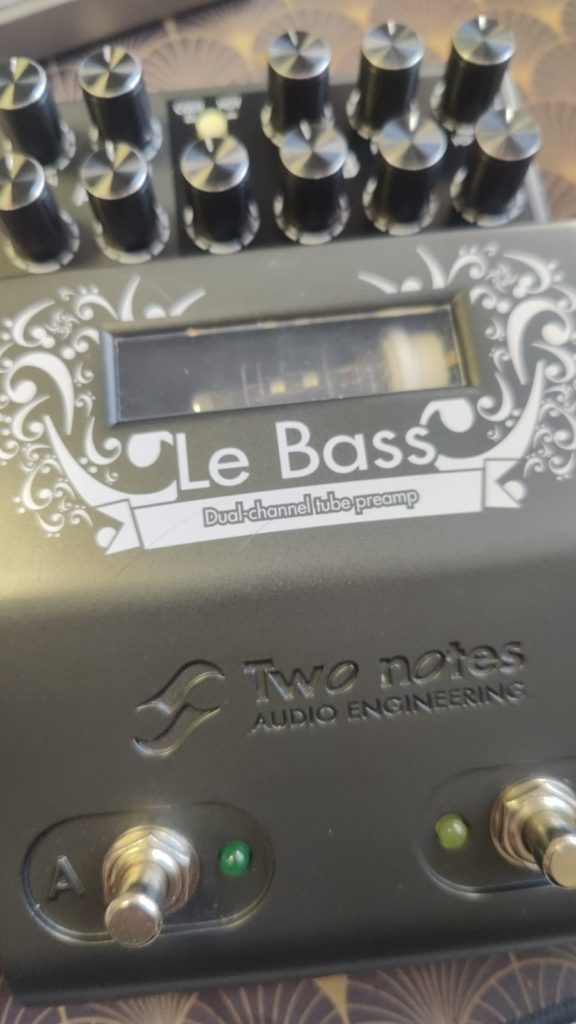Two Notes Le Bass

Strictly speaking, the Two Notes Le Bass is a dual channel preamp. It has some interesting functions.
You get a clean channel with two band EQ and a dirt channel with a three band EQ that has parametric mids. On top of that, you get the option of running both channels at the same time, either in series or in parallel, called hot fusion and cold fusion, with a mix knob that lets you decide how much of which channel you get when both are running. In theory, that should get you three different sounds to work with.
The clipping stage is housed inside the glass container of a 12AX7 vacuum tube, which runs at proper voltage. To get that going, the pedal is relatively hungry, demanding 12V DC with 500mA. The form factor is somewhat unusual, the pedal is quite long, so you cannot mount it very well on a small pedalboard like a Pedaltrain Nano.
The signal enters the pedal via 1/4″ jack, then there is an FX loop that sits after the Le Bass preamp section, and for output you get another 1/4″ jack for unbalanced signal, a 1/8″ jack for headphones and an XLR balanced out. There is a cab sim that can be switched on and off, only affecting the headphone and XLR outputs. I tried the headphone out with my 320 Ohm Sennheisers and it was powerful enough to drive them.
Hooking everything up and playing the first notes, I have the feeling that the clean channel does have a baked in flavor to it. Nothing crass, but there is a difference between device on and device off with the knobs at noon. But it works for me, since it sounds pleasing to my ears. Finding a very simple, yet effective setup here, I quickly jump over to the more promising channel B. Channel B is the one that can do drive, and it starts very gentle, like a tube amp that tries to stay clean but runs just a tiny little bit too hot. Increasing the gain leads to more of that. For a long time, the feeling is that of a vintage amp that is driven into saturation.Trying the fusion mode, I find that the red one works much better than the blue one, but I don’t understand the knob. It obviously does more when you turn it up, but does it increase the level of channel A firing into channel B? I’ll have to open the manual. (The manual confirms my suspicion, in Hot Fusion, it increases how hot A gets fired into B). But that comes with a problem: The volume of the Fusion channel is really hard to match with the other channels. You get useful sounds out of it, but it’s near impossible to get A, B and the Fusion channel to sit well in a mix. You’ll have to decide which two you want to match and then live with the third being out. While I’m dealing out criticism, I’m gonna go on and say the cab sim is really useful in channel B and in fusion, when you have drive, but it kinda muffles the output of channel A. It would have been nice to be able to opt that out somehow, so you get a crystal clear channel A and a cab sim when you need it because you use drive.
It seems the intuitive thing to do would be to set A to a modern sound, a bit of a bathtub so you get massive, articulated lows and airy, sparkly highs and then set B to a vintage tube amp style. More mids, less sparkle, but instead of the sparkle, some hair on top. In the medium gain settings the Le Bass is very civilized and that bit of hair should sit well in many styles.
I tried it out live, using it as the only device between my bass and the PA system and it really delivered as promised. I got to use both channels, A for big lows and open top, B for a mellow, easy drive that really works in anything guitar driven.
But, getting snobby, I have to admit I don’t really get much of the magic tube sound in the clean channel.
I did confirm with Two Sound that both channels actively use the tube. When I compare the A channel to the Noble, the A channel stinks. Yes, I compared the made in China, $200 pedal to the holy grail that’s six times as much and has a year-long waiting list. Also, comparing the B channel to other devices that can do this kind of sound, like the Fake Plastic Trees, or the Tonehammer – both devices that run on solid state technology, the latter do sound at least as tube-like as the Le Bass, but they run on conventional 9V with a tiny current draw.
To sum it up: The Le Bass is a cool two channel device that actually has two differently voiced channels, once crystal clear and one vintage voiced, plus ways to combine them (which don’t always work as hoped). Drawbacks are the form factor and the power requirements, plus the cab sim that is cool on one channel but sucks on the other.